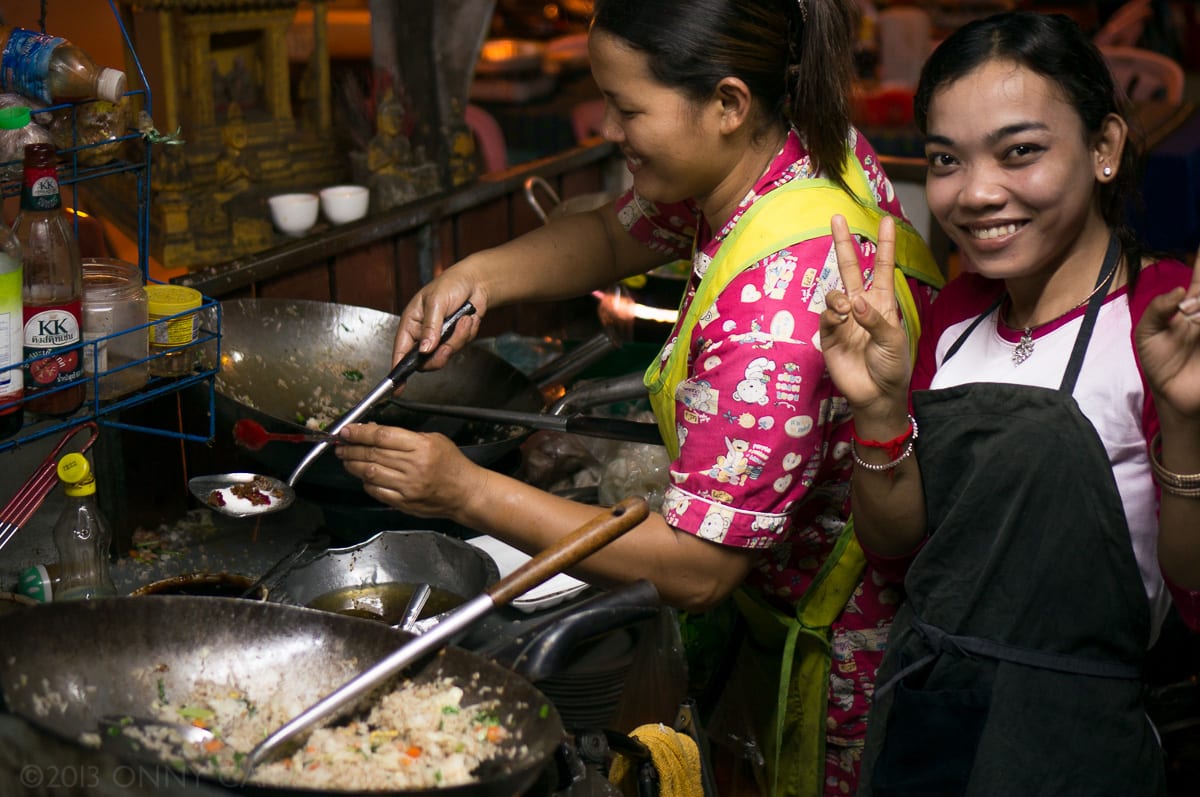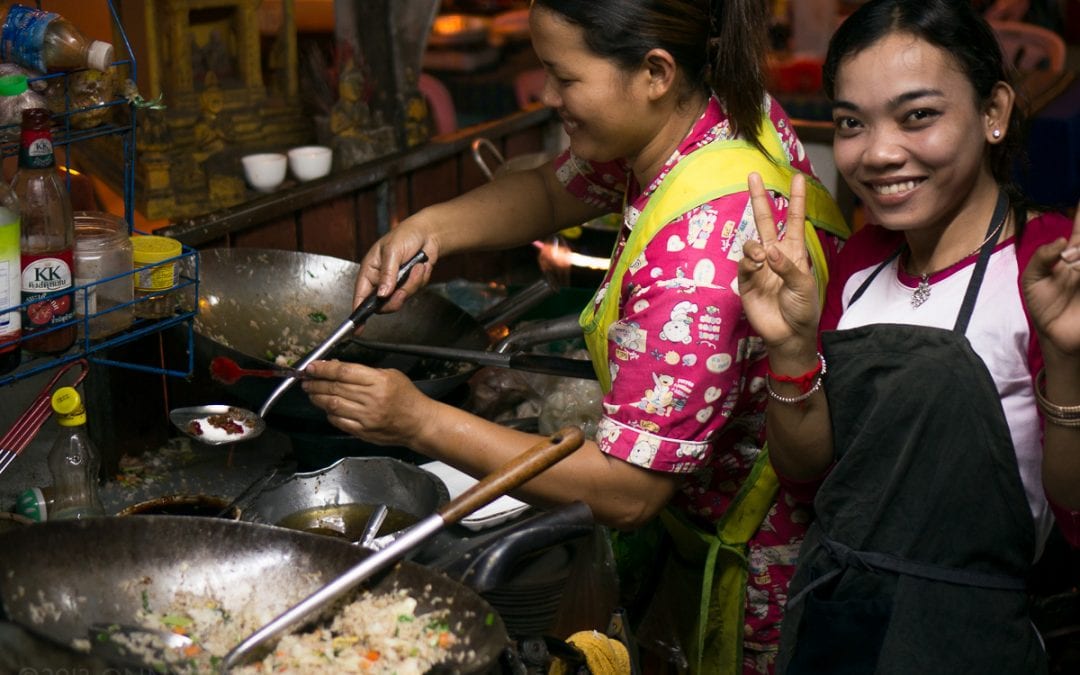
Photo credit: Andrea Williams
Cambodia is an intriguing, unique country that has had a tumultuous and colourful past. Its location as the southern region of the Indochina Peninsula enabled it to become an important part of sea trade in the 2nd century. It welcomed ships from India, China, Persia, and Europe, bringing in cultures as well as goods from those particular parts of the world. During the Dark ages of Cambodia, its neighbours Thailand and Vietnam took turns in attempting to invade the weakened country before it became a protectorate of France in 1863. More recently, the Khmer Rouge regime led by Pol Pot led to the genocide of at least 1.5 million Cambodian people, which was then followed by the Cambodian-Vietnamese war. All of these events contributed to the development of the unique culture that embodies Cambodia today.
An important part of a country’s culture is its cuisine, and Cambodia’s street food is not only a manifestation of Cambodia’s cuisine, it’s a revelation of Cambodia people’s everyday life.
As with street food in many Asian countries, Cambodia has many varieties of street food, including snacks, refreshments, and even meals that could be made in a few short minutes. Many street stalls provide seating designed for quick eating (e.g., small plastic tables and stools), allowing locals and visitors to sit down for a fast, tasty meal that costs only a couple of dollars.
Here we present some of our favourite street foods that you can find in Cambodia!

Fish amok (Photo credit: Jordan Rockerbie)
Fish Amok
Fish amok, often thought of as the national dish of Cambodia, is a creamy curry dish made with freshwater fish and typically served with white rice. One of the key ingredients in the curry is turmeric, a spice from India. Though clearly Indian-inspired, the dish is uniquely Cambodian, from the way it is steamed in banana leaves, to the use of local herbs in the concoction of the curry, to the use of river fish as the main protein.
While fish amok is available both as a street food and as a restaurant dish, the street version is unlikely to be the traditional version that is steamed with the banana leaf, but rather a “fast food” version that mixes the ingredients in a wok.
Baguette / Num Pang
Num Pang is a sandwich made with the French baguette (yes, there is still a lot of French influence in Cambodia!). Common ingredients of the sandwich include pork, cucumbers, carrots, chives, coriander, and onions. Num pang is sold on food carts, although modernisation of the sandwich has resulted in sandwich shops opening up in bigger cities that offer more varieties of this beloved sandwich. And in fact, New Yorkers may already be familiar with the name Num Pang, as there is now a sandwich shop of the same name in New York that sells the Cambodian-inspired namesake and has proven to be very popular in the city.

Lok lak
Lok Lak
Lok lak is a simple dish traditionally made with beef in a tomato sauce garnished with onions, tomato, and lettuce. It is topped with a fried egg, a dash of salt and pepper, and a squeeze of fresh lime. Lok lak is another dish that was brought over by the French.

Snails on a cart
Snails and Frogs
Here are some street food items that are not for the squeamish! While it’s understandable to assume that eating snails and frogs is a result of direct culinary influences from the French (à la escargots and cuisses de grenouille), the actual backstory may not be so straightforward. Aside from snails and frogs, Cambodians also snack on snakes, tarantulas, worms, and crickets. Consuming insects and amphibians may be a custom passed on from the Khmer Rouge regime, when people had very little to eat and had to find alternative sources of protein.
While the French tends to consume only the legs of the frog, the entire frog is prepared as food in Cambodia. A popular way of preparing frogs is to grill them. Sometimes the frogs are stuffed with pork, and sometimes they are stuffed with crushed peanuts and lemongrass.
Snails in Cambodia are often grilled or boiled, sometimes with cola added for taste. They are often sold in plastic bags, seasoned with salt and spices.

Prahok
Prahok
The local version of mayonnaise is prahok—a crushed, salted and fermented fish paste that is used in Cambodian cuisine as a seasoning, a condiment or a dipping sauce. A true staple of the Khmer cuisine, It originated as a fish-preservation method for the months of the year when fresh fish was not as plentiful (in fact, freshwater fishing is now banned in the country to provide a chance for the fish to lay eggs). Ideally, the prahok goes through one to three years of fermentation, and the best prahok is arguably found in Siem Reap.
Nom Ga Chai / Chive Cakes
Chive cakes is another Chinese-inspired snack that has become a popular Cambodian street food. It’s simply a pocket of light flour dough filled with chives that is pan-fried to a golden yellow, and is served with fish sauce for dipping. This classic and filling snack can be found on food carts and in markets.

Bamboo sticky rice (Photo credit: Ivo Verhaar)
Kralan / Bamboo Sticky Rice
Last but not least, dessert! Kralan is a confection of sticky rice, beans, grated coconut and coconut milk roasted in a bamboo section over a charcoal fire.
We hope that has whetted your appetite and that you will give some of these Cambodian treats a try when you come and volunteer with us! Alternatively, don’t hesitate to book a cooking lesson as part of your overseas adventure. Learn how to cook one of these dishes and fill your home with the smell of Cambodia.

